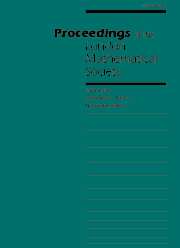Article contents
Differential operators and the Steenrod algebra
Published online by Cambridge University Press: 01 July 1997
Abstract
The Novikov-Landweber algebra and the Steenrod algebra are set up in terms of the primitive differential operators $D_k=\sum_i x_i^{k+1}\frac{\partial}{\partial x_i}$ acting in the usual way on the integral polynomial ring ${\bf Z}[x_1,\ldots ,x_n,\ldots]$. A commutative wedge product $\vee$ for differential operators is introduced and it is shown that the iterated wedge product $D_k^{\vee r}$ is divisible by $r!$ as an integral operator. The divided differential operator algebra $\cal D$ is generated over the integers by the divided operators $\frac{D_k^{\vee r}}{r!}$ under the wedge product. $\cal D$ is additively isomorphic to the abelian group of symmetric functions in the variables $x_i$. Furthermore $\cal D$ is closed under composition of operators and admits a natural coproduct which makes it a Hopf algebra in two ways, with respect to the composition and wedge products. Under composition $\cal D$ is isomorphic to the Landweber-Novikov algebra. A Hopf sub-algebra is generated under composition by the integral Steenrod squares $SQ^r = \frac{D_1^{\vee r}}{r!}$ and reduces mod 2 to the Steenrod algebra. An explicit product formula for two wedge expressions is developed and used to derive Milnor's product formula for his basis elements in the Steenrod algebra. The hit problem in the Steenrod algebra is reformulated in terms of partial differential operators.
1991 Mathematics Subject Classification 55S10.
- Type
- Research Article
- Information
- Copyright
- London Mathematical Society 1997
- 8
- Cited by


